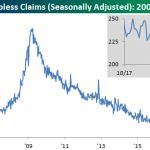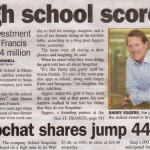Introduction and summary
It is now possible to pencil in how the next credit crisis is likely to develop. At its centre is an overvalued dollar over-owned by foreigners, puffed up on speculative flows driven by interest rate differentials. These must be urgently corrected by the European Central Bank and the Bank of Japan if the distortion is to be prevented from becoming much worse.
The problem is compounded because the next crisis is likely to be triggered by this normalization. It can be expected to commence in the coming months, even by the year-end. When flows into the dollar subside and reverse, bond yields can be expected to rise sharply in all the major currencies. There will also be a number of other unhelpful factors, particularly rising commodity prices, the timing of the Trump stimulus and trade tariffs pushing up price inflation. Coupled with a declining dollar, price inflation and therefore interest rates are bound to rise significantly.
Then there is another problem: when it comes to rescuing the global financial system from the systemic fall-out, not only will the challenge be greater than at the time of the Lehman crisis, but legislative changes, such as confusing bail-in provisions, have made it more difficult to execute.
There is also evidence that during the last credit crisis in 2008, the Russians were tempted to interfere with the Fed’s rescue attempts, potentially crashing the whole US financial system. At that time, they failed to get the support of the Chinese. Now that Russia has disposed of most of its dollar investments in return for gold, and following an escalation of geopolitical conflicts, a new financial crisis may be regarded as an opportunity by America’s enemies to emasculate America’s financial and geopolitical power.
The outlook for the dollar and all dollar-dependent assets is not good. The only protection will be the possession of physical gold and silver, beyond the reach of systemically-threatened banks.
Mega-currency strains
The chattering classes in financial markets have droned on and on about how the Fed’s interest rate policies are creating crises in emerging markets. But emerging markets are likely to be just bit players in a new global tragedy. As Shakespeare put it in Macbeth, they are “but walking shadows, a poor player who struts and frets his hour upon the stage, and then is heard no more….”
In the process, the real problem has been under-reported, and that is the strains between the mega-currencies: the dollar, the euro, and the yen. Could they be the leading players in the next credit crisis, and if so how will the tragedy unfold?
You only have to note the disparity in bond yields, particularly at the short end of the yield curve, to see what is moving money. Two-year US Treasuries yield 2.74%, while the two-year German bund yields minus 0.55%. Two-year JGBs at minus 0.12% are also out of whack with USTs. You do not get disparities like this at the short end of the yield curve without moving massive quantities of short-term money.
Putting currency risk to one side for a moment, a Eurozone bank, insurance company or pension fund is taxed on short-term investments in bunds through negative yields, while being offered a tempting and potentially increasing yield on similar risk USTs.
Tempting, isn’t it?
Obviously, we can’t ignore currency risk. For simplicity, we will assume that fully matched risk insurance more or less eliminates the profit opportunity. It is possible to use out-of-the-money currency derivatives to cap the risk, and indeed, that’s one reason why OTC foreign currency derivatives stood at over $87 trillion in the second half of last year.
But we digress slightly. Maximum profits are obtained by taking a naked punt, and here, the trend is your best friend. If you feel sure the dollar is going up against the euro, not only will a euro-based financial institution gain more than three per cent by holding two-year USTs over equivalent sovereign risk two-year bunds, but there is the juicy prospect of a currency gain as well. We will also note that the Fed still plans to raise interest rates while the ECB does not. That should ensure currency risk is kept safely at bay.
Euro-based financial institutions must be sorely tempted. Furthermore, the dollar stopped falling in April and since then its trend has been up. Talk in the market is of dollar shortages as emerging-market governments may be forced to cover dollar liabilities, which coupled with Fed-induced interest rate rises makes further dollar gains against the euro, and even the yen, appear to be a racing certainty.
Convinced yet?
We can be sure that euro-based traders have been salivating over the prospect, particularly with Italian risk soaring and therefore a further reason to sell euros, which are by far the largest component in the dollar’s trade-weighted index. Hedge funds based in Europe and the US must also be keen on this trade, for the same reasons. The only question remaining is how to maximize the opportunity. Fortunately, banks and dealing intermediaries are queueing up to lend against high-quality short maturity USTs, either directly or by way of reverse repurchase agreements. A bank loan for a credible customer will secure gearing of eight or ten times, and a reverse repo even more.
Let’s stick with ten times. Finance costs are based on euro or yen money-market rates, which for three-month euros is minus 0.3%, and for yen 0%. For ten times gearing, before fees, we can, therefore, expect a gross return of 30% per annum in euros by buying two-year USTs, or 26% in yen before exchange rate gains and price changes. It is not much less investing in 13-week Treasury bills for cash players on the same geared basis.
Little wonder this is becoming the biggest game in Financetown. The attraction of these differentials between the major currencies is why the US Government has encountered no problem financing its budget deficits. And so long as the ECB and the BOJ insist on negative and zero rates and the ECB continues printing money to buy Italian bonds, it can go on forever.
That is the dollar bulls’ case. For balance we need to introduce a note of caution. Whenever we see a sure-fire way to make grillions of dollars, experience tells us it is time to do the opposite. Vide equities in 1999-2000. Vide residential mortgages in 2007-08. Vide the growth of shadow banking in 2007-08 to finance speculation. Today, we have something far larger: excessive speculation in favor of the dollar and against everything else. The most destabilizing element for the dollar it is not the walking shadows in emerging markets, but the relationship between the dollar and the euro, and to a lesser extent the Japanese yen. This interest rate cum bond yield arbitrage is bound to prove particularly destabilizing for Eurozone markets as well.








Leave A Comment